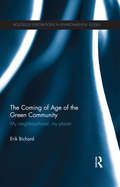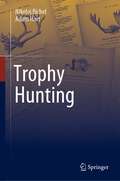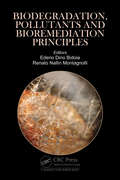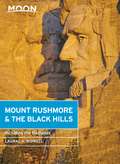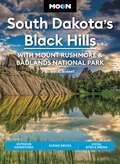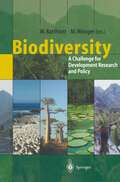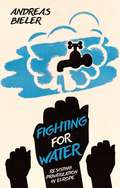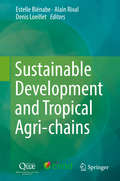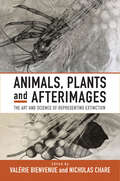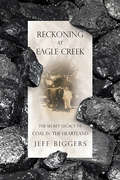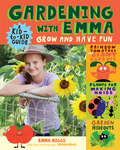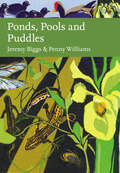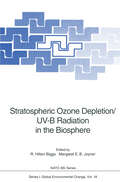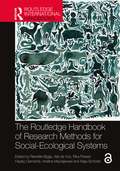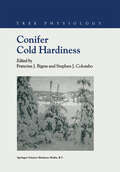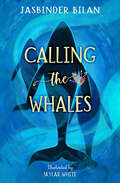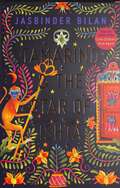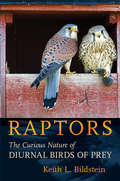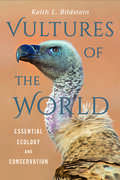- Table View
- List View
The Coming of Age of the Green Community: My neighbourhood, my planet (Routledge Explorations in Environmental Studies)
by Erik BichardPeople organising to protect their environment is not a new phenomenon, but the groups that have been pushing for environmental change since the 1970s have not convinced sufficient numbers make sustainable decisions or to lead sustainable lives. Governments have serially failed to do the job at the international level. Now, climate change, resource depletion and widening social aspirations threaten to destabilise human society unless sustainable change can be influenced from another direction. The Coming of Age of the Green Community explores the activities of a new generation of community-led initiatives that may herald the beginnings of the next wave of activism. Erik Bichard combines the testimonies of dozens of group activists with historic evidence and the views of a range of commentators from a variety of disciplines to put forward reasons why some green community groups succeed while others fail. He concludes with a valuable prescription for both existing and emerging groups on how to be sustainable, both over time and in their actions. This book address one of the key questions of the twenty-first century: has the local perspective on this universal concern finally come of age?
The Coming of Age of the Green Community: My neighbourhood, my planet (Routledge Explorations in Environmental Studies)
by Erik BichardPeople organising to protect their environment is not a new phenomenon, but the groups that have been pushing for environmental change since the 1970s have not convinced sufficient numbers make sustainable decisions or to lead sustainable lives. Governments have serially failed to do the job at the international level. Now, climate change, resource depletion and widening social aspirations threaten to destabilise human society unless sustainable change can be influenced from another direction. The Coming of Age of the Green Community explores the activities of a new generation of community-led initiatives that may herald the beginnings of the next wave of activism. Erik Bichard combines the testimonies of dozens of group activists with historic evidence and the views of a range of commentators from a variety of disciplines to put forward reasons why some green community groups succeed while others fail. He concludes with a valuable prescription for both existing and emerging groups on how to be sustainable, both over time and in their actions. This book address one of the key questions of the twenty-first century: has the local perspective on this universal concern finally come of age?
Trophy Hunting
by Nikolaj Bichel Adam HartThis book gets to the heart of trophy hunting, unpacking and explaining its multiple facets and controversies, and exploring why it divides environmentalists, the hunting community, and the public. Bichel and Hart provide the first interdisciplinary and comprehensive approach to the study of trophy hunting, investigating the history of trophy hunting, and delving into the background, identity and motivation of trophy hunters. They also explore the role of social media and anthropomorphism in shaping trophy hunting discourse, as well as the viability of trophy hunting as a wildlife management tool, the ideals of fair chase and sportsmanship, and what hunting trophies are, both literally and in terms of their symbolic value to hunters and non-hunters. The analyses and discussions are underpinned by a consideration of the complex moral and practical conflicts between animal rights and conservation paradigms. This book appeals to scholars in environmental philosophy, conservation and environmental studies, as well as hunters, hunting opponents, wildlife management practitioners, and policymakers, and anyone with a broad interest in human–wildlife relations.
Oxygen Transport to Tissue—IV (Advances in Experimental Medicine and Biology #159)
by Haim I. BicherThe International Society on OXygen Transport to Tissue (ISO'IT) has canpleted nine years as a society since its first fonnal meeting at Charleston-Clanson, South Carolina, United States of America in 1973. Prior to this time an active group of scientists and engineers rret in w::>rkshop environrrents, on a periodic basis, around the w::>rld. Meetings are ncM on an annual basis, alternating between Europe and the United States. The international gatherings include scientists and engineers in a variety of fields. ISOIT has produced a stable forum for the exchange of info:rmation on the rnicroenvirornnent of living cells, ranging fran the utilization of mathematics and engineering, through physiology and radiobiology, to clinical applications. The proceedings of these meetings have been codified into six books, four of them published by Plenum Press in its prestigious Advances in Experimental Medicine and Biology series. This volume, together with the next two volumes that will follCJV.l the meetings in Dortmund, Gennany in 1982 and in Ruston, Louisiana in 1983 will provide further chapters in the history of this fascinating field of knCJV.lledge. OUr thanks are given to all the participants and contributors to the Detroit meeting. We hope that the strength of the society will grow in caning years, and that our contribution will eventually be felt in :inproving the treatment of the sick, and in enhancing the thought processes of the intellectual.
Biodegradation, Pollutants and Bioremediation Principles
by Ederio Dino BidoiaThis book presents a broad compendium of biodegradation research and discussions on the most up-to-date bioremediation strategies. The most relevant microbiological, biochemical and genetic concepts are presented alongside the fundamentals of bioremediation. The topics include: a wide variety of contaminant impacts evaluation, key methodologies required to measure biodegradation and propose new bioremediation protocols, as well as the handling of microbial communities related to such processes. The selected collaborating authors are renowned for their microbiology expertise and will provide an in-depth reference for students and specialists. The contents provide a valuable source of information for researchers, professionals, and policy makers alike.
Biodegradation, Pollutants and Bioremediation Principles
by Ederio Dino Bidoia Renato Nallin MontagnolliThis book presents a broad compendium of biodegradation research and discussions on the most up-to-date bioremediation strategies. The most relevant microbiological, biochemical and genetic concepts are presented alongside the fundamentals of bioremediation. The topics include: a wide variety of contaminant impacts evaluation, key methodologies required to measure biodegradation and propose new bioremediation protocols, as well as the handling of microbial communities related to such processes. The selected collaborating authors are renowned for their microbiology expertise and will provide an in-depth reference for students and specialists. The contents provide a valuable source of information for researchers, professionals, and policy makers alike.
Moon Mount Rushmore & the Black Hills: With the Badlands (Travel Guide)
by Laural A. BidwellExperience the open skies of the Badlands, the rolling prairies of the West, and one of America's most famous monuments with Moon Mount Rushmore & The Black Hills. Inside you'll find:Flexible Itineraries: Unique and adventure-packed ideas for day trips, a week on the road, families with kids, wildlife enthusiasts, and moreThe Best Hikes Near Mount Rushmore: Individual trail maps, mileage and elevation gains, and trailheadsExperience the Outdoors: Find ideas for horseback riding, rock climbing, backpacking, kayaking, biking, and more. Say hello to the carved granite faces of the presidents and hike red rock canyons and hills covered in ponderosa pine. Spot bison, elk, and mountain goats and see wild horses roaming the grassy flatlands. Climb the tallest peak east of the Rockies or navigate the underground passages of Wind Cave National Park Respectfully connect with Native American culture: Visit historic sites, galleries, and museums to learn about Lakota history, see the Crazy Horse Memorial, or attend a powwow ceremony to watch traditional dances and sample authentic cuisineHow to Get There: Up-to-date information on gateway towns, park entrances, park fees, and toursWhere to Stay: Campgrounds, resorts, hotels, and morePlanning Tips: When to go, what to pack, safety information, and how to avoid the crowds, with full-color photos and detailed maps throughoutExpertise and Know-How: Experience the best of this stunning region with Laural A. Bidwell, a local of South Dakota's Black Hills Get to know Mount Rushmore and the Black Hills your way with Moon.Craving more of the great outdoors? Check out Moon USA National Parks, Moon Zion & Bryce, or Moon Yellowstone & Grand Teton.
Moon South Dakota's Black Hills: Outdoor Adventures, Scenic Drives, Local Bites & Brews (Travel Guide)
by Laural A. BidwellExperience the open skies of the Badlands, the rolling prairies of the West, and one of America's most famous monuments with Moon South Dakota's Black Hills. Inside you'll find:Flexible itineraries: Unique and adventure-packed ideas for day trips, a week on the road, families with kids, wildlife enthusiasts, and more The best hikes in the Black Hills and Badlands, with individual trail descriptions, elevation gains, and trailheads Experience the outdoors: Go horseback riding, rock climbing, backpacking, kayaking, biking, and more. Say hello to the carved granite faces of the presidents and hike red rock canyons and hills covered in ponderosa pine. Spot bison, elk, and mountain goats and see wild horses roaming the grassy flatlands. Climb the tallest peak east of the Rockies or navigate the underground passages of Wind Cave National Park Respectfully connect with Native American culture: Visit historic sites, galleries, and museums to learn about Lakota history, see the Crazy Horse Memorial, or attend a powwow ceremony to watch traditional dances and sample authentic cuisine How to get there: Up-to-date information on gateway towns, park entrances, park fees, and tours Where to stay: Campgrounds, resorts, hotels, and more Planning tips: When to go, what to pack, safety information, and how to avoid the crowds, with full-color photos and detailed maps throughout Expertise and know-how: Experience the best of this stunning region with Laural A. Bidwell, a local of South Dakota's Black Hills Get to know South Dakota your way with Moon. Craving more of the great outdoors? Check out Moon USA National Parks, Moon Zion & Bryce, or Moon Yellowstone & Grand Teton. About Moon Travel Guides: Moon was founded in 1973 to empower independent, active, and conscious travel. We prioritize local businesses, outdoor recreation, and traveling strategically and sustainably. Moon Travel Guides are written by local, expert authors with great stories to tell—and they can't wait to share their favorite places with you. For more inspiration, follow @moonguides on social media.
Biodiversity: A Challenge for Development Research and Policy
by N. BiedingerBiodiversity, sometimes simply understood as "diversity of species", is a specific quality of life on our planet, the dimensions and importance of which have just lately been fully realized. Today we know that "biological diversity is a global asset of incalculable value to present and future generations" (Kofi Annan). Biodiversity is spread unequally over the world: in fact, the main share of biological resources worldwide is harboured predominantly by the so-called developing countries in the tropics and sub tropics. Therefore, Biodiversity - A Challenge for Development Research and Policy was chosen as the title for an international conference which was held in Bonn in 1997 as one of the first major events organized by the then newly established North-South Centre for Development Research (ZEF) at Rheinische Friedrich-Wilhelms-Universitat Bonn (Germany). Since the ZEF, founded by the Senate of the University of Bonn in 1995, has played a central role in turning Bonn into a centre for international cooperation and North-South dialogue. The Centre is a product of the Bonn Berlin agreement of July 1994 which was adopted to offset the effects caused by the Parliament and much of the Government moving to Berlin. It fits in well with the double strategy to strengthen Bonn's position as an interna tional science arena and as an eminent place for development policy and the national and supranational agencies dealing with this issue.
Fighting for Water: Resisting Privatization in Europe
by Andreas BielerIn the wake of the global financial crisis, water services have come under renewed neoliberal assault across Europe. At the same time, the struggle against water privatization has continued to pick up pace; from the re-municipalization of water in Grenoble in 2000, to the United Nations declaration of water as a human right in 2010.In Fighting for Water, Andreas Bieler draws on years of extensive fieldwork to dissect the underlying dynamics of the struggle for public water in Europe. By analysing the successful referendum against water privatization in Italy, the European Citizens' Initiative on 'Water and Sanitation are a Human Right', the struggles against water privatization in Greece and water charges in Ireland, Bieler shows why water has been a fruitful arena for resistance against neoliberal restructuring.
Fighting for Water: Resisting Privatization in Europe
by Andreas BielerIn the wake of the global financial crisis, water services have come under renewed neoliberal assault across Europe. At the same time, the struggle against water privatization has continued to pick up pace; from the re-municipalization of water in Grenoble in 2000, to the United Nations declaration of water as a human right in 2010.In Fighting for Water, Andreas Bieler draws on years of extensive fieldwork to dissect the underlying dynamics of the struggle for public water in Europe. By analysing the successful referendum against water privatization in Italy, the European Citizens' Initiative on 'Water and Sanitation are a Human Right', the struggles against water privatization in Greece and water charges in Ireland, Bieler shows why water has been a fruitful arena for resistance against neoliberal restructuring.
Sustainable Development and Tropical Agri-chains
by Estelle Biénabe Alain Rival Denis LoeilletThis book links tropical agri-chain dynamics – with which CIRAD and AFD have been involved for decades – to that of sustainable development. Increased environmental and social concerns urge agri-chain actors and development practitioners to design innovations, and public and private actors to invent regulations in connection with agri-chains to improve sustainability.With a view to contributing towards implementing the Sustainable Development Goals (SDGs), this book examines the different roles of agri-chains: as vectors of development, as spaces of innovation, as objects of evaluation, and as arenas of regulation. It builds upon the findings and experiences of CIRAD and its researchers together with their Southern partners, and of AFD and its officers.Linking agricultural production with the other economic sectors, agri- chains are key spaces where local and global challenges to sustainability meet and where local and global actors experiment interlinked or common solutions.
Animals, Plants and Afterimages: The Art and Science of Representing Extinction
by Valérie Bienvenue Nicholas ChareThe sixth mass extinction or Anthropocene extinction is one of the most pervasive issues of our time. Animals, Plants and Afterimages brings together leading scholars in the humanities and life sciences to explore how extinct species are represented in art and visual culture, with a special emphasis on museums. Engaging with celebrated cases of vanished species such as the quagga and the thylacine as well as less well-known examples of animals and plants, these essays explore how representations of recent and ancient extinctions help advance scientific understanding and speak to contemporary ecological and environmental concerns.
Reckoning at Eagle Creek: The Secret Legacy of Coal in the Heartland
by Jeff BiggersCultural historian Jeff Biggers takes us to the dark amphitheatre ruins of his family's nearly 200-year-old hillside homestead that has been strip-mined on the edge of the first federally recognized Wilderness Site in southern Illinois. In doing so, he not only comes to grips with his own denied backwoods heritage, but also chronicles a dark and missing chapter in the American experience: the historical nightmare of coal outside of Appalachia, serving as an exposé of a secret legacy of shame and resiliency.
Gardening with Emma: Grow and Have Fun: A Kid-to-Kid Guide
by Emma Biggs Steven BiggsEmma Biggs, an enthusiastic 13-year-old with a love of gardening, shares her just-for-kids advice on growing a food garden, including theme garden ideas and tips for preparing, planting, and caring for a garden, along with creative ways to have fun doing it.
Ponds, Pools and Puddles (Collins New Naturalist Library)
by Jeremy Biggs Penny WilliamsPonds and pools are a common feature of our landscape – there are at least ten times as many ponds as lakes in the UK – and they are also important wildlife habitats. This book provides a comprehensive and detailed account of these freshwater habitats.
Stratospheric Ozone Depletion/UV-B Radiation in the Biosphere (Nato ASI Subseries I: #18)
by R. Hilton Biggs Margaret E. B. JoynerDo changes in stratospheric ozone relate to changes in UV-B irradiance and do both relate to life on Earth? This volume presents the latest data available in the basic scientific disciplines associated with these questions. The key topics are the interactive factors between the various research elements and the measurements needed to both validate ozone depletion and monitor UV flux changes in the biosphere.
The Routledge Handbook of Research Methods for Social-Ecological Systems (Routledge International Handbooks)
by Reinette Biggs Alta De Vos Rika Preiser Hayley Clements Kristine Maciejewski Maja SchlüterThe Routledge Handbook of Research Methods for Social-Ecological Systems provides a synthetic guide to the range of methods that can be employed in social-ecological systems (SES) research. The book is primarily targeted at graduate students, lecturers and researchers working on SES, and has been written in a style that is accessible to readers entering the field from a variety of different disciplinary backgrounds. Each chapter discusses the types of SES questions to which the particular methods are suited and the potential resources and skills required for their implementation, and provides practical examples of the application of the methods. In addition, the book contains a conceptual and practical introduction to SES research, a discussion of key gaps and frontiers in SES research methods, and a glossary of key terms in SES research. Contributions from 97 different authors, situated at SES research hubs in 16 countries around the world, including South Africa, Sweden, Germany and Australia, bring a wealth of expertise and experience to this book. The first book to provide a guide and introduction specifically focused on methods for studying SES, this book will be of great interest to students and scholars of sustainability science, environmental management, global environmental change studies and environmental governance. The book will also be of interest to upper-level undergraduates and professionals working at the science–policy interface in the environmental arena.
The Routledge Handbook of Research Methods for Social-Ecological Systems (Routledge International Handbooks)
by Reinette Biggs Alta De Vos Rika Preiser Hayley Clements Kristine Maciejewski Maja SchlüterThe Routledge Handbook of Research Methods for Social-Ecological Systems provides a synthetic guide to the range of methods that can be employed in social-ecological systems (SES) research. The book is primarily targeted at graduate students, lecturers and researchers working on SES, and has been written in a style that is accessible to readers entering the field from a variety of different disciplinary backgrounds. Each chapter discusses the types of SES questions to which the particular methods are suited and the potential resources and skills required for their implementation, and provides practical examples of the application of the methods. In addition, the book contains a conceptual and practical introduction to SES research, a discussion of key gaps and frontiers in SES research methods, and a glossary of key terms in SES research. Contributions from 97 different authors, situated at SES research hubs in 16 countries around the world, including South Africa, Sweden, Germany and Australia, bring a wealth of expertise and experience to this book. The first book to provide a guide and introduction specifically focused on methods for studying SES, this book will be of great interest to students and scholars of sustainability science, environmental management, global environmental change studies and environmental governance. The book will also be of interest to upper-level undergraduates and professionals working at the science–policy interface in the environmental arena.
Conifer Cold Hardiness (Tree Physiology #1)
by F. J. Bigras Stephen J. ColomboConifer Cold Hardiness provides an up-to-date synthesis by leading scientists in the study of the major physiological and environmental factors regulating cold hardiness of conifer tree species. This state-of-the-art reference comprehensively explains current understanding of conifer cold hardiness ranging from the gene to the globe and from the highly applied to the very basic. Topics addressed encompass cold hardiness from the perspectives of ecology, ecophysiology, acclimation and deacclimation, seedling production and reforestation, the impacts of biotic and abiotic factors, and methods for studying and analyzing cold hardiness. The content is relevant to geneticists, ecologists, stress physiologists, environmental and global change scientists, pathologists, advanced nursery and silvicultural practitioners, and graduate students involved in plant biology, plant physiology, horticulture and forestry with an interest in cold hardiness.
Assay of Calcium-regulating Hormones
by Daniel D. BikleThe ability to measure accurately the hormones regulating calcium homeosta sis is the fundamental first step toward understanding the roles these hormones play in health and disease. Techniques for such measurements have only been available for the past 10 years or so and remain in a state of rapid development. Sensitive parathyroid hormone (PTH) radioimmunoassays appeared in the early 1970s, and with them came a whole new appreciation for the prevalence and implications of hyperparathyroidism, primary or secondary, in the popu lation. The calcitonin (CT) radioimmunoassay came later and achieved rapid success in the. diagnosis of a previously poorly understood cancer, medullary carcinoma of the thyroid, frequently associated with the familial multiple endo crine neoplasia type 2 syndromes (a and b). As the sensitivity of the calcitonin radioimmunoassay has improved, our understanding of the role of calcitonin in normal physiological processes has increased. The knowledge that vitamin D must be metabolized to produce its biologic effects is only 15 years old. This has had profound implications in our understanding of a variety of metabolic bone, kidney, and gastrointestinal diseases. Assays to measure the major cir culating form of vitamin D, 25-hydroxyvitamin D, were described 10 years ago. Assays for the other metabolites, in particular, 1,25-dihydroxyvitamin D, were described even more recently. As of today, we know of many vitamin D metabolites and have developed the techniques to measure most of them; how ever, many questions remain concerning their physiological role.
Calling the Whales
by Jasbinder BilanWhen a majestic whale is stranded near their Scottish hometown, Tulsi and Satchen are determined to save it. But after their boat capsizes in a storm, they’re left dangerously adrift. Just as all seems lost, help arrives from an unexpected source … An adventure with a powerful eco message at its heart.
Tamarind & the Star of Ishta (PDF)
by Jasbinder BilanFrom the author of the Costa Award-winning Asha & the Spirit Bird comes a breathtaking, magical adventure ... WINNER OF THE INDIE CHILDREN'S BOOK AWARD LONGLISTED FOR THE BLUE PETER BOOK AWARD 'I absolutely adored it ... an achingly beautiful story' Sita Brahmachari 'A lush, gorgeous setting in a novel as vivid and original as her Costa-winning debut.' The Guardian 'Beautifully written, richly atmospheric and touchingly spiritual, this brief novel sparkles like a polished gem' Daily Mail Tamarind never knew her Indian mum, who died soon after she was born. So when she arrives at her ancestral home, a huge mansion in the Himalayas surrounded by luxuriant gardens, she's full of questions for her extended family. But instead of answers, she finds an ominous silence - and a trickle of intriguing clues: an abandoned hut, a friendly monkey, a glowing star ring, and a strange girl in the garden who calls herself Ishta.
Raptors: The Curious Nature of Diurnal Birds of Prey
by Keith L. BildsteinRaptors are formally classified into five families and include birds—such as eagles, ospreys, kites, true hawks, buzzards, harriers, vultures, and falcons—that are familiar and recognized by many observers. These diurnal birds of prey are found on every continent except Antarctica and can thrive in seemingly inhospitable spots such as deserts and the tundra. They have powerful talons and hooked beaks for cutting and tearing meat, and keen binocular vision to aid in their hunting prowess. Because of their large size, distinctive feeding habits, and long-distance flight patterns, raptors intrigue humans and have been the subject of much general interest as well as extensive scientific research. Keith L. Bildstein has watched and studied raptors on five continents and is well prepared to explain their critical importance, not only as ecological entities but also as inspirational tokens across natural and human-dominated landscapes. His book offers a comprehensive and accessible account of raptors, including their evolutionary history, their relationships to other groups of birds, their sensory abilities, their general natural history, their breeding ecology and feeding behavior, and threats to their survival in a human-dominated world. Biologically sound but readable, Raptors is a nontechnical overview of this captivating group. It will allow naturalists, birders, hawk-watchers, science educators, schoolchildren, and the general public, along with new students in the field of raptor biology, to understand and appreciate these birds, and in so doing better protect them.
Vultures of the World: Essential Ecology and Conservation
by Keith L. BildsteinIn Vultures of the World, Keith L. Bildstein provides an engaging look at vultures and condors, seeking to help us understand these widely recognized but underappreciated birds. Bildstein's latest work is an inspirational and long overdue blend of all things vulture. Based on decades of personal experience, dozens of case studies, and numerous up-to-date examples of cutting-edge science, this book introduces readers to the essential nature of vultures and condors. Not only do these most proficient of all vertebrate scavengers clean up natural and man-made organic waste but they also recycle ecologically essential elements back into both wild and human landscapes, allowing our ecosystems to function successfully across generations of organisms. With distributions ranging over more than three-quarters of all land on five continents, the world's twenty-three species of scavenging birds of prey offer an outstanding example of biological diversity writ large. Included in the world's species fold are its most abundant large raptors—several of its longest lived birds and the most massive of all soaring birds. With a fossil record dating back more than fifty million years, vultures and condors possess numerous adaptions that characteristically serve them well but at times also make them particularly vulnerable to human actions. Vultures of the World is a truly global treatment of vultures, offering a roadmap of how best to protect these birds and their important ecology.
